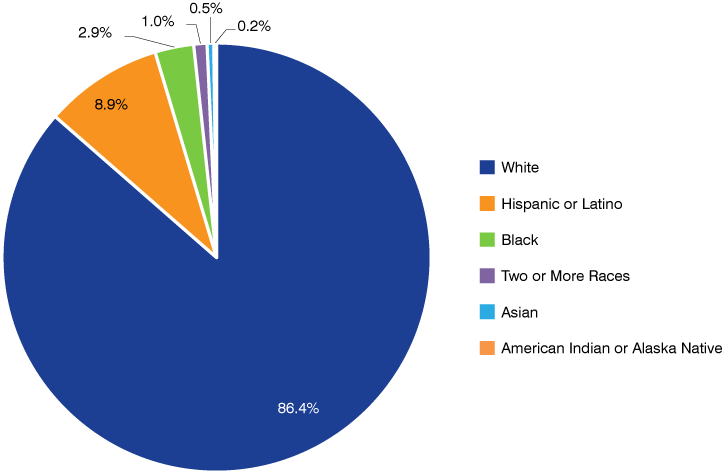Building opportunity: Diversifying Indiana's construction workforce to bridge labor gaps

Builders in the state likely can’t continue building houses at the pace that the strong permit issuance demands with current levels of workforce capacity. Many construction trade groups and organizations assert that cultivating gender and racial/ethnic diversity in their workforce presents a solution to the crisis.
The construction sector has experienced substantial growth in the United States and Indiana in the past few years. According to U.S. Bureau of Labor Statistics (BLS) data, in December 2023 the state’s construction employment was 15% greater than in January 2019. Even more telling, it was 27% greater than the depths of the pandemic lockdowns in April 2020.
Despite this growth, construction companies are raising alarm bells about labor shortages they expect to become even more acute over the next decade-plus. What factors are contributing to these shortages and how can the state and the nation alleviate them and demonstrate that the sector offers a viable pathway to the middle class?
The short answer is to increase racial/ethnic and gender diversity in the workforce and rehabilitate the image of construction jobs as a backbreaking, “last resort” career. This article will explore the dynamics of the state’s construction industry and chart a course toward building a more resilient and inclusive workforce.
The construction workforce yesterday and today
On its face, construction employment is relatively strong statewide, buttressed by a building boom that started during the pandemic and shows little sign of abating. Central Indiana, in particular, has experienced high demand for new construction: in December 2023, builders filed 524 applications for new single-family housing construction in the nine-county region centered on Marion County—up 36% from December 2022—which marked the sixth-straight month of rising permit filings.1
Statewide, builders filed 1,385 permits for single-family homes in December, which was a decrease from the 2023 peak in August (1,675 permits) but still about 40% greater than in December 2022 (987).2 Figure 1 shows seasonally adjusted single-family permits from January 2019 to December 2023. Filings peaked in January 2022 but fell consistently over the year, before starting to rise again in January 2023. Since building permits are a lagging indicator of construction activity, the trend suggests that 2024 will be a strong year for residential construction across the state.
Figure 1: Single-family building permits issued in Indiana

Note: These data are seasonally adjusted.
Source: U.S. Census Bureau via FRED
This highlights the need for additional workers in the sector to keep up with demand. Consider Figure 2, which demonstrates the relationship between single-family housing permits and employment in the construction of buildings subsector (NAICS 236) from January 2014 to December 2023. To facilitate comparison between the two series, they are indexed so that January 2014 = 100. Note that using the subsector “construction of buildings” instead of the sector “construction” more precisely captures residential housing construction.3
Figure 2: Single-family building permits issued and employment in construction of buildings in Indiana

Note: These data are seasonally adjusted. January 2014 = 100.
Source: U.S. Census Bureau and U.S. Bureau of Labor Statistics via FRED
You can see that the upward trends of employment and permit issuance tracked closely from 2014 through 2019, but once the pandemic hit, their trajectories became erratic. After a decrease of about 10% from March to April 2020, employment in the industry showed consistent growth at a slightly faster pace than from 2014 to 2019, while permit issuance boomed (through 2021), then busted (during 2022), then began to rise again (during 2023).4
The future of the construction workforce
Builders in the state likely can’t continue building houses at the pace that the strong permit issuance demands with current levels of workforce capacity. Signs of the struggle are revealed in national data about the number of unfilled jobs: Per BLS data, 449,000 construction jobs went unfilled in December 2023, which is just slightly higher than the 445,000 average construction job openings per month in the last quarter of 2023.5 This is a record high and a “strong indication that the labor shortages that have long plagued the construction industry remain firmly in place,” according to Associated Builders and Contractors chief economist Anirban Basu.6
Many construction trade groups and organizations assert that cultivating gender and racial/ethnic diversity in their workforce presents a solution to the crisis. According to the Indiana Construction Roundtable Foundation (ICRF), the state needs 1,100 new construction workers by 2026.7 The ICRF—noting the average age of a construction worker is around 50 years old and that the industry is composed of only 11% female workers—sees opportunities to alleviate labor shortages through getting more women into the field.
Women are an overlooked and underengaged source of labor for the industry. “If you think about our industry, overall, 11% is female, and 4% of skilled trade is female,” Chris Price, the ICRF’s president, said. “If we can just move that number to, say, 25%, we no longer have a workforce shortage.”8
There is potential to ease shortages by broadening racial and ethnic diversity in the sector. Per Lightcast, a labor market analytics firm, Indiana’s construction sector was 86% white in 2023. Hispanic or Latino workers comprised the highest share of the industry’s minority workforce at 9%, followed by Black workers at 3% and workers of two or more races at 1%, with other minority groups representing less than 1% of the workforce (see Figure 3).
Figure 3: Racial and ethnic composition of Indiana's construction workforce, 2023

Note: Native Hawaiian or Other Pacific Islander comprise only about 0.03% of the construction workforce and are not shown in the chart.
Source: Lightcast
Embracing diversity to solve workforce challenges
Lightcast forecasts a 3.4% increase in construction jobs from 2023 to 2033 in Indiana, which represents a need of nearly 6,700 workers. Given the aging, predominantly male and predominantly white workforce of today, the best chance the state has at growing the industry for tomorrow is investing in young, female and minority workers.
Considering many young people are looking for alternatives to a traditional four-year college degree—short-term certificates, apprenticeships, trades education, the military, forgoing post-secondary education altogether, etc.—the time for the industry to reach out to these individuals is now. The state and the industry must partner to show the value of a career in construction for all workers, particularly those who have been left out because of racial and gender biases.
Recruiting and retaining talent from underrepresented groups requires proactive measures like training programs, summer camps, mentorships and apprenticeships. One example is the Heavy Metal Summer Experience, a nonprofit organization that teaches adolescents how to work with sheet metal piping in dozens of locations across North America, including Greenwood, Indiana.9 Indiana should pursue more programs like this to introduce individuals to the industry and give them the opportunity to learn valuable skills.
Stakeholders should also work to revamp the perception of working in construction. While physical labor is still required in many construction jobs, the industry has evolved with new technology. Recruiters should highlight the variety of career pathways to attract talent.
Stakeholders also must ensure that female and minority workers pursuing a career in construction have the resources and support they need to be successful in the profession. Companies must foster a culture of inclusivity and respect and provide avenues for mentorship and professional development for historically marginalized groups.
Price, the ICRF president, sees this as an existential issue: “If we can make our job sites and culture welcoming to all people, we will no longer have these challenges. If we don’t, the cost is that we won’t be able to grow as a state.”
Notes
- IBJ staff. “Area homebuilders optimistic after late-year surge in permit filings.” Indianapolis Business Journal. January 25, 2024. https://www.ibj.com/articles/area-homebuilders-optimistic-after-late-year-surge-in-permit-filings.
- U.S. Census Bureau, New private housing units authorized by building permits: 1-unit structures for Indiana [INBP1FHSA], retrieved from FRED, Federal Reserve Bank of St. Louis; https://fred.stlouisfed.org/series/INBP1FHSA, January 26, 2024.
- The subsector construction of buildings (NAICS 236) is composed of the industry groups residential building construction (2361) and nonresidential building construction (2362). The subsector level is as precise as monthly data from the BLS Current Employment Statistics gets.
- Ibid., and U.S. Bureau of Labor Statistics and Federal Reserve Bank of St. Louis, All employees: Construction of buildings in Indiana [SMU18000002023600001SA], retrieved from FRED, Federal Reserve Bank of St. Louis; https://fred.stlouisfed.org/series/SMU18000002023600001SA, January 29, 2024.
- Phillips, Zachary. “Job openings drop, but demand persists.” Construction Dive. January 31, 2024. https://www.constructiondive.com/news/construction-job-openings-high-wages/706110/.
- Associated Builders and Contractors. “Construction job openings remain elevated in December, says ABC.” January 30, 2024. https://www.abc.org/News-Media/News-Releases/construction-job-openings-remain-elevated-in-december-says-abc.
- Hackler, Meredith. “More construction workers are needed in Indiana, women joining the industry could be the solution.” WRTV. December 8, 2023. https://www.wrtv.com/news/local-news/more-construction-workers-are-needed-in-indiana-women-joining-the-industry-could-be-the-solution.
- Ibid.
- Jobsite editorial. “Why women and minorities can be the keys to combating the construction labor shortage.” Jobsite by Procore. August 14, 2023. https://www.procore.com/jobsite/why-women-and-minorities-can-be-the-keys-to-combating-the-construction-labor-shortage. Also see the Heavy Metal Summer Experience website, which lists the locations across the U.S. and Canada: https://www.hmse.org/.
